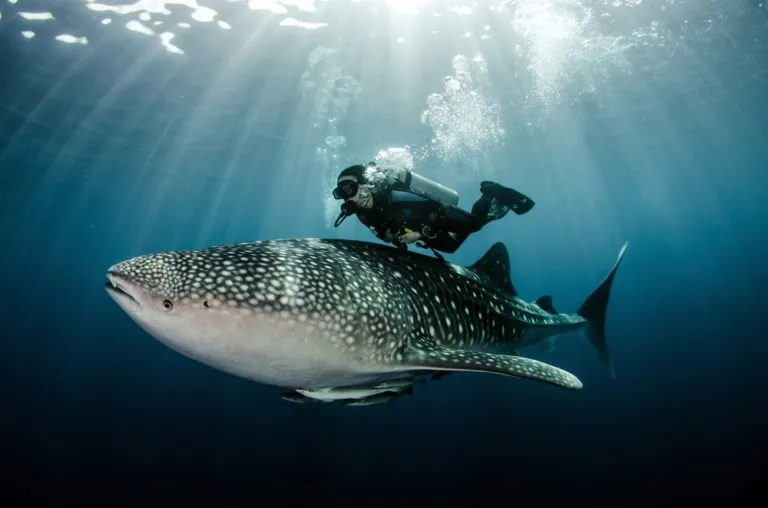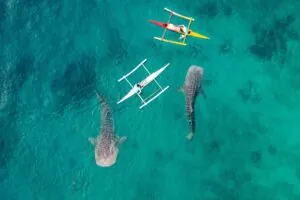Species Spotlight: Whale Sharks

Diving or snorkeling with a Whale Shark is one of the most sought out dive experiences. The Whale Shark is the largest fish in the ocean and part of the shark family. The gigantic size of the Whale Shark and their disposition attract divers. They are docile and have a curious nature that allows divers to swim closely and interact with them. Swimming with a Whale Shark is the highlight of any dive.
HOW BIG IS A WHALE SHARK
A Whale Shark can measure up to forty feet and can weigh up to 20,000 pounds. Their mouths are three feet wide and hold 350 rows of teeth. A Whale Shark spends up to 8 hours a day gulping up to 10,000 gallons of ocean water. Feeding mostly on plankton, the Whale Shark is known to eat small fish, krill, copepods, and fish eggs. They are filter feeders. The Whale Shark uses pads located in the back of the throat to push water through their gills as food is pushed through the Whale Shark’s quarter-sized throat.
Whale Sharks are characterized by their large, wide mouths and distinctive blue-grey coloring with white spots. The spots, like a human fingerprint, are unique to the Whale Shark and used to track and identify them.
The Whale Shark tends to be a solitary creature that wanders the ocean. They migrate 5,000 miles each year to consume enough food. At 3 miles per hour, these slow-moving giants travel to different feeding grounds around the world.
ARE WHALE SHARKS DANGEROUS
Although the Whale Shark is the largest fish in the ocean, they are not aggressive or a threat to humans. Divers often swim right next to them. Both snorkeling and diving are fantastic ways to encounter Whale Sharks as they swim in both shallow and deep waters. Depending on the location, one might favor the other. Whale Sharks roam in all temperate waters except the Mediterranean Sea.

Humans are the biggest threat to the existence of the Whale Shark. In Asia, the Whale Shark is hunted for its meat and their fins are considered a delicacy. Because of their size, they can become tangled accidentally in fishing gear. The Whale Shark is an endangered species and conservation efforts are underway.
Being in the water with the Whale Shark is both exhilarating and tranquil. Encounters with these giant creatures are virtually guaranteed in several parts of the world at the right time, ensuring divers a life-changing experience.
BEST PLACES TO DIVE WITH WHALE SHARKS
Ningaloo Reef boasts fringing reef that spans Australia’s west coast and currently holds the highest rate of Whale Shark swim numbers, making it one of the best places to swim with Whale Sharks. Whale Sharks are consistently found congregating here each year. Some of the best times to swim and interact with Whale Sharks are March through June in Coral Bay and early August in Exmouth.
Galapagos is known to have the most sightings of the largest Whale Sharks on record. Diving areas with Whale Sharks are accessible by liveaboards only. The northmost islands of Darwin and Wolf are the best know locations for interactive Whale Shark dives with July through December being the very best months for sightings.
Maldives is comprised of 1200 small islands with only 200 that are inhabited. In this remote dive location in the Arabian Sea, smaller Whale Sharks come to Maldives to feed, and grow staying about 2 months on average. There is a strong possibility of a Whale Shark sighting at any time during the year but especially during the feeding spectacular from August to October.
Baa Atoll boasts diving sites for beginners to experts with overhangs, swim-throughs, and an overabundance of Whale Sharks.
Mexico sees more Whale Sharks than any other country in the world. Cancun, Cozumel and Baja California are the most popular areas to swim with them.
In Cancun and Cozumel, Isa Holbox, Isa Contoy and Isla Mujeres are beautiful islands that provide excellent snorkeling with Whale Sharks. Cancun only allows snorkeling.
Baja California offers excellent opportunities to swim and dive with Whale Sharks. La Paz, Cabo San Lucas and Cabo Pulmo National Park are distinguished as having first-rate dives with Whale Sharks.
With some of the most picturesque diving in the world, Koh Tao is at the top of many divers’ lists. With the choice of twenty dive locations, Koh Tao offers Shark Whale interactions for any level of divers. The months of February through May are exceptional times to dive and swim with Whale Sharks. Chumphon Pinnacle is a large dive spot located 45 minutes from Koh Tao and home to an enormous, submerged granite pinnacle. Southwest Pinnacle offers scattered, broken granite rock pinnacle and an abundance of Whale Sharks.
St Helena:
St Helena is an Atlantic outcrop that has recently opened for divers. The optimal time for Shark Whale sightings is in December through May. This is the only known area where male and female Whale Sharks congregate in the same location.
Tanzania boasts the highest (Mt. Kilimanjaro) and the lowest (Lake Tanganyika) points on the continent of Africa. Tanzania is surrounded on all sides by water: the Indian Ocean to the east, the great rift valley lakes of Africa, Lake Victoria, Tanganyika and Malawi to the northwest, west and southwest. Due to the rich feeding terrain, Whale Sharks are permanent residents in this area. The peak season for spotting Whale Sharks is October through March and divers can enjoy shore diving, liveaboards, and boat diving experiences. Tanzania top dive locations are Pemba Island and Zanzibar.
Tofu Beach in southern Mozambique, is the called the Whale Shark capital of the world. This off the beaten path, undiscovered gem is located close to South Africa. The best time to visit Mozambique to swim with these gentle giants is between June and January.
The ocean is a remarkable place where divers and snorkelers can discover wonderful treasures! There are no terrible dives as each dive reveals something new and special in nature. The exhilaration of encountering a Whale Shark will leave divers completely breathless and excited about subsequent underwater adventures.
